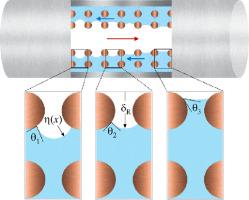当前位置:
X-MOL 学术
›
Int. J. Heat Mass Transf.
›
论文详情
Our official English website, www.x-mol.net, welcomes your
feedback! (Note: you will need to create a separate account there.)
On the deflection of the liquid–vapor interface in a wicked heat pipe
International Journal of Heat and Mass Transfer ( IF 5.0 ) Pub Date : 2021-02-01 , DOI: 10.1016/j.ijheatmasstransfer.2020.120638 Muhammad Rizwanur Rahman , Prashant R. Waghmare , M.R. Flynn
International Journal of Heat and Mass Transfer ( IF 5.0 ) Pub Date : 2021-02-01 , DOI: 10.1016/j.ijheatmasstransfer.2020.120638 Muhammad Rizwanur Rahman , Prashant R. Waghmare , M.R. Flynn

|
Abstract The shape of the liquid-vapor interface along the length of the adiabatic section of a heat pipe - a passive heat transfer device that relies on capillary pumping - is investigated to identify the mechanisms behind both performance enhancement techniques as well as operational failure. In formulating the associated mathematical model, the liquid flow within the (screen type) wick is described using Darcy’s law while Poiseuille’s equation is applied for the vapor phase. The liquid and vapor phases are coupled together using the Young-Laplace equation with additional closure provided by select thermodynamic relations e.g. to relate the temperature and pressure changes experienced by the vapor. Our model thereby predicts the shape of the liquid-vapor interface and its deflection owing to the variations in the heat load, operating temperature and the wick-surface characteristics. Together, these details can prescribe the parameter space over which the liquid-vapor interface remains mechanically-stable meaning that the heat pipe can function effectively. The possibility of employing a wick with non-uniform wetting characteristics is also explored with comparisons drawn against the uniform wettability case. The comparison in question reveals some of the benefits of the former approach. For instance, a wick exhibiting a contact angle that varies as a function of the axial coordinate allows for better control of (i) the depth to which the interface is recessed within the wires comprising the wick, and, therefore (ii) the entrainment of liquid droplets into the counter-flowing vapor stream. As such, the space of acceptable operating parameters can be suitably expanded.
中文翻译:

热管中液气界面的偏转
摘要 研究了沿热管绝热段长度的液体 - 蒸汽界面的形状 - 一种依赖毛细管泵送的被动传热装置 - 被研究以确定性能增强技术和操作故障背后的机制。在制定相关的数学模型时,(筛网类型)灯芯内的液体流动使用达西定律描述,而泊肃叶方程适用于气相。液相和气相使用杨拉普拉斯方程耦合在一起,并通过选择的热力学关系提供额外的闭合,例如关联蒸汽所经历的温度和压力变化。我们的模型因此预测了液体 - 蒸汽界面的形状及其由于热负荷变化而引起的偏转,工作温度和灯芯表面特性。总之,这些细节可以规定液-气界面保持机械稳定的参数空间,这意味着热管可以有效运行。通过与均匀润湿性情况的比较,还探讨了使用具有非均匀润湿特性的灯芯的可能性。有问题的比较揭示了前一种方法的一些好处。例如,呈现出作为轴向坐标的函数而变化的接触角的芯允许更好地控制(i)界面在包括芯的线内凹进的深度,并且因此(ii)夹带液滴进入逆流的蒸气流。这样,可以适当扩大可接受的操作参数的空间。
更新日期:2021-02-01
中文翻译:

热管中液气界面的偏转
摘要 研究了沿热管绝热段长度的液体 - 蒸汽界面的形状 - 一种依赖毛细管泵送的被动传热装置 - 被研究以确定性能增强技术和操作故障背后的机制。在制定相关的数学模型时,(筛网类型)灯芯内的液体流动使用达西定律描述,而泊肃叶方程适用于气相。液相和气相使用杨拉普拉斯方程耦合在一起,并通过选择的热力学关系提供额外的闭合,例如关联蒸汽所经历的温度和压力变化。我们的模型因此预测了液体 - 蒸汽界面的形状及其由于热负荷变化而引起的偏转,工作温度和灯芯表面特性。总之,这些细节可以规定液-气界面保持机械稳定的参数空间,这意味着热管可以有效运行。通过与均匀润湿性情况的比较,还探讨了使用具有非均匀润湿特性的灯芯的可能性。有问题的比较揭示了前一种方法的一些好处。例如,呈现出作为轴向坐标的函数而变化的接触角的芯允许更好地控制(i)界面在包括芯的线内凹进的深度,并且因此(ii)夹带液滴进入逆流的蒸气流。这样,可以适当扩大可接受的操作参数的空间。











































 京公网安备 11010802027423号
京公网安备 11010802027423号